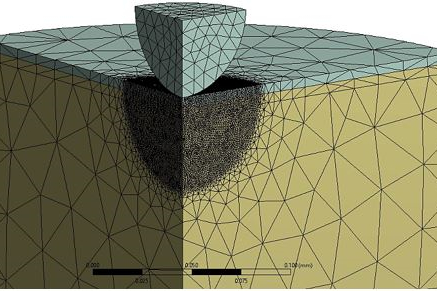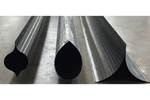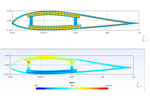University of Illinois Chicago leverages SwiftComp software to improve understanding of porous coatings
Software to accelerate development and adoption of new composite materials for manufacturing by predicting effects of porosity level on strength.
Share

Coating/substrate structure under a nanoindentation tip to measure the mechanical response of the component. Photo Credit: AnalySwift LLC
AnalySwift LLC (West Jordan, Utah, U.S.) a Purdue University-affiliated software company that provides efficient high-fidelity modeling software for composites, announces that the University of Illinois Chicago (UIC) is
participating in its Academic Partner Program (APP), and it is using its SwiftComp simulation software for researching new porous coatings for use in manufacturing. The APP offers participating universities no-cost licenses of engineering software programs SwiftComp and VABS to enable students, researchers and faculty to leverage the tools in their academic research.
More specifically, the SwiftComp program is a general-purpose, truly multi-scale modeling code for composites and other heterogeneous materials. It directly and seamlessly links detailed microstructure and structural behavior for composite structures including beams, plates/shells and 3D structures. Broad applications include high-strain composites in deployable space structures, printed circuit boards (PCBs), high-end fishing rods, honeycomb sandwich structures and many more.
“We are excited by the work being done by the University of Illinois at Chicago on new materials for manufacturing and pleased they have selected SwiftComp as part of their simulation efforts,” says Allan Wood, president and CEO of AnalySwift.
According to UIC’s Professor of Materials Engineering Santanu Chaudhuri, the university uses nano-to-macroscale simulation tools to accelerate the development and adoption of new materials for manufacturing. “Our group, Accelerated Materials Research Lab [AMRL] is in the Civil, Materials and Environmental engineering department at UIC. AMRL connects materials design to materials manufacturing and performance. Using computational and experimental methods, we develop novel methods for accelerating the transition of materials from design inception to deployment. AMRL tools and capabilities help realize the goals of computational materials design and connect synthesis to scalable materials processing for a circular economy.”
According to Chaudhuri, AMRL implemented the Mechanics of Structure Genome (MSG) concept in SwiftComp to calculate the effective elastic and mechanical properties of porous coatings under different loading conditions. The test case for the study was a zirconia-silica bilayer coating on aluminum alloy. Simulation results reportedly enabled the group to understand the effects of porosity level on the strength of the macroscale structure, and local stress, strain fields aided in the study of the failure mechanisms in such coatings under nanoindentation tips. “SwiftComp allowed us to determine the effective properties of the materials that enabled us to accurately simulate the mechanical response of the components.” Chaudhurri adds.
“In general, zirconia-silica conversion coatings are considered as a potential alternative to chromium-based conversion coatings, which are fabricated with toxic chemicals,” continues Dr. Samaei. “Not only can zirconia-silica-based conversion coatings provide excellent corrosion protection for metals and alloys used in aerospace applications, but they can also be manufactured using non-toxic chemicals via a plasma-based deposition process.”
Related Content
-
ASCEND program update: Designing next-gen, high-rate auto and aerospace composites
GKN Aerospace, McLaren Automotive and U.K.-based partners share goals and progress aiming at high-rate, Industry 4.0-enabled, sustainable materials and processes.
-
NASA names university teams for aeronautics research challenges
As part of the agency’s University Leadership Initiative, three multidisciplinary teams will address topics related to growth in AAM, while a fourth examines electricity generation for future airliners.
-
AMRC Training Centre introduces composites apprenticeship opportunity
With partners McLaren and Teledyne CML Composites, the Training Center will train new composites technicians in South Yorkshire to build up the future industry workforce.
















